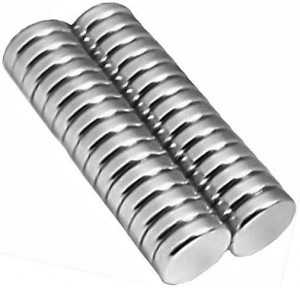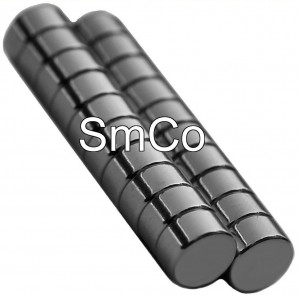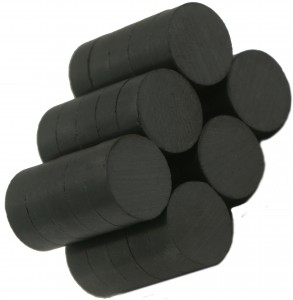What are the different types of magnets?
There are several different types of magnets, each with their own set of characteristics. If you are using magnets in any DIY, home improvement or science project it is important to know the differences to choose the best magnet for the job.
First, it is important to mention that there’s also a subset of magnets━permanent and electromagnet. Electromagnets require a source of electricity and can be turned on or off, whereas, permanent magnets retain their magnetism. In this blog, we are focusing on permanent magnets. The main types are:
 Neodymium magnets[/caption]
These are often called simply neodymium magnets and are made through an extensive process using rare earth metals. They are also the most common and generally the most powerful of the four types. If you are looking for a magnet with a strong, secure hold, then neodymium is usually a good choice. However, because they are made of iron, they can rust in wet conditions or when exposed to water for long periods of time. This can also make them more brittle than some of the other types.
Neodymium magnets[/caption]
These are often called simply neodymium magnets and are made through an extensive process using rare earth metals. They are also the most common and generally the most powerful of the four types. If you are looking for a magnet with a strong, secure hold, then neodymium is usually a good choice. However, because they are made of iron, they can rust in wet conditions or when exposed to water for long periods of time. This can also make them more brittle than some of the other types.
 Samarium Cobalt Magnets[/caption]
Samarium cobalt magnets are another relatively powerful type. They were created in the 1970s, before NdFeB magnets. One of the benefits with using SmCo is that they are less prone to corrosion and have a better temperature resistance. This means that it is best at retaining its magnetism at extremely high or low temperatures, and is a good choice for applications in which unusually high or low temperatures are a factor. They are slightly less powerful than neodymium magnets, however.
Samarium Cobalt Magnets[/caption]
Samarium cobalt magnets are another relatively powerful type. They were created in the 1970s, before NdFeB magnets. One of the benefits with using SmCo is that they are less prone to corrosion and have a better temperature resistance. This means that it is best at retaining its magnetism at extremely high or low temperatures, and is a good choice for applications in which unusually high or low temperatures are a factor. They are slightly less powerful than neodymium magnets, however.
 Ceramic magnets[/caption]
Ceramics are another commonly used type of magnet. They are so common because they are generally less expensive to make and acquire. They are not as powerful as neodymium, but for basic crafts, fridge magnets, or holding lightweight items they are a cost-effective option.
Knowing the different types of magnets and their strengths and weaknesses can help you choose the right ones in your projects. But, we are also here to help you decide. If you have questions about which products to use in a specific project, contact us for assistance.
Ceramic magnets[/caption]
Ceramics are another commonly used type of magnet. They are so common because they are generally less expensive to make and acquire. They are not as powerful as neodymium, but for basic crafts, fridge magnets, or holding lightweight items they are a cost-effective option.
Knowing the different types of magnets and their strengths and weaknesses can help you choose the right ones in your projects. But, we are also here to help you decide. If you have questions about which products to use in a specific project, contact us for assistance.
- Neodymium iron boron (NdFeB)
- Samarium cobalt (SmCo)
- Alnico
- Ceramic or ferrite magnets
NdFeB Magnets
[caption id="attachment_1219" align="alignnone" width="300"] Neodymium magnets[/caption]
These are often called simply neodymium magnets and are made through an extensive process using rare earth metals. They are also the most common and generally the most powerful of the four types. If you are looking for a magnet with a strong, secure hold, then neodymium is usually a good choice. However, because they are made of iron, they can rust in wet conditions or when exposed to water for long periods of time. This can also make them more brittle than some of the other types.
Neodymium magnets[/caption]
These are often called simply neodymium magnets and are made through an extensive process using rare earth metals. They are also the most common and generally the most powerful of the four types. If you are looking for a magnet with a strong, secure hold, then neodymium is usually a good choice. However, because they are made of iron, they can rust in wet conditions or when exposed to water for long periods of time. This can also make them more brittle than some of the other types.
SmCo Magnets
[caption id="attachment_1218" align="alignnone" width="300"] Samarium Cobalt Magnets[/caption]
Samarium cobalt magnets are another relatively powerful type. They were created in the 1970s, before NdFeB magnets. One of the benefits with using SmCo is that they are less prone to corrosion and have a better temperature resistance. This means that it is best at retaining its magnetism at extremely high or low temperatures, and is a good choice for applications in which unusually high or low temperatures are a factor. They are slightly less powerful than neodymium magnets, however.
Samarium Cobalt Magnets[/caption]
Samarium cobalt magnets are another relatively powerful type. They were created in the 1970s, before NdFeB magnets. One of the benefits with using SmCo is that they are less prone to corrosion and have a better temperature resistance. This means that it is best at retaining its magnetism at extremely high or low temperatures, and is a good choice for applications in which unusually high or low temperatures are a factor. They are slightly less powerful than neodymium magnets, however.
Alnico Magnets
Alnico magnets stand for the components that make them up━aluminum, nickel and cobalt. Alnico are not as widely used as the other types of magnets, and have been replaced by NdFeB, SmCo and ceramic. They aren’t as powerful as the other types, but they can be used in basic applications like fridge magnets. But, it can even be harder to find them, because of the other types.Ceramic or Ferrite Magnets
[caption id="attachment_1217" align="alignnone" width="293"] Ceramic magnets[/caption]
Ceramics are another commonly used type of magnet. They are so common because they are generally less expensive to make and acquire. They are not as powerful as neodymium, but for basic crafts, fridge magnets, or holding lightweight items they are a cost-effective option.
Knowing the different types of magnets and their strengths and weaknesses can help you choose the right ones in your projects. But, we are also here to help you decide. If you have questions about which products to use in a specific project, contact us for assistance.
Ceramic magnets[/caption]
Ceramics are another commonly used type of magnet. They are so common because they are generally less expensive to make and acquire. They are not as powerful as neodymium, but for basic crafts, fridge magnets, or holding lightweight items they are a cost-effective option.
Knowing the different types of magnets and their strengths and weaknesses can help you choose the right ones in your projects. But, we are also here to help you decide. If you have questions about which products to use in a specific project, contact us for assistance.
